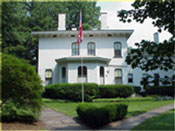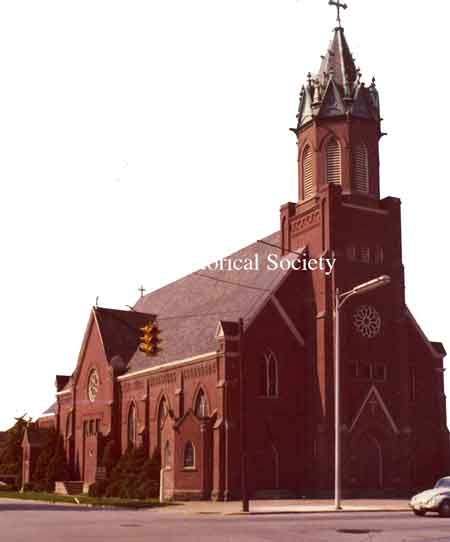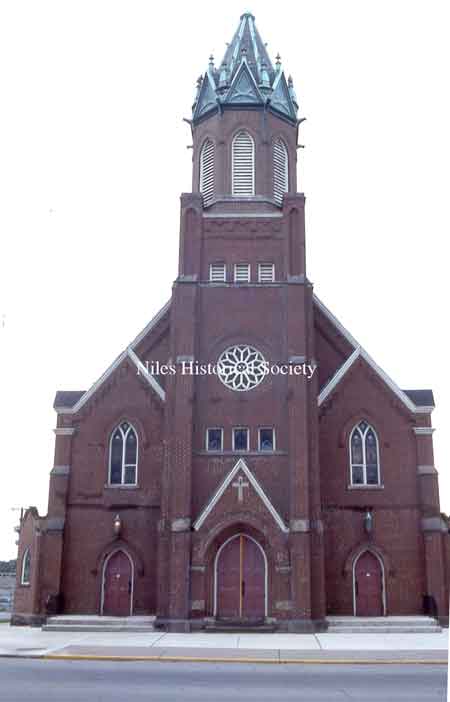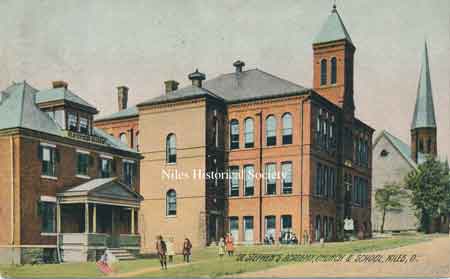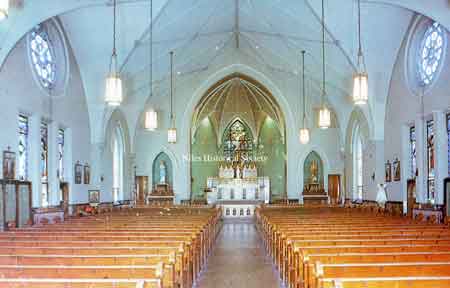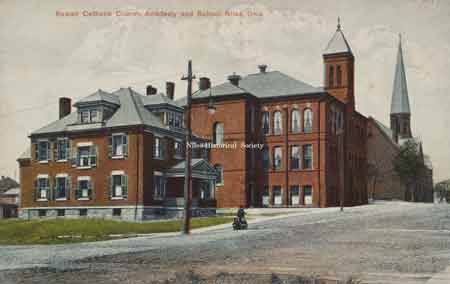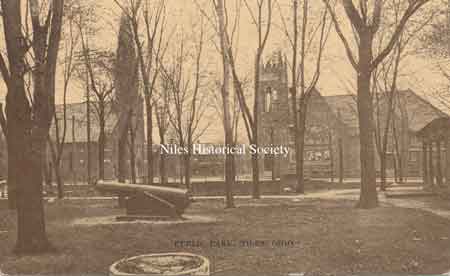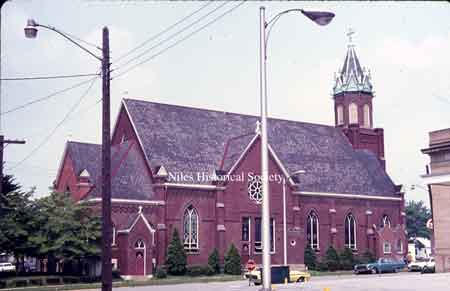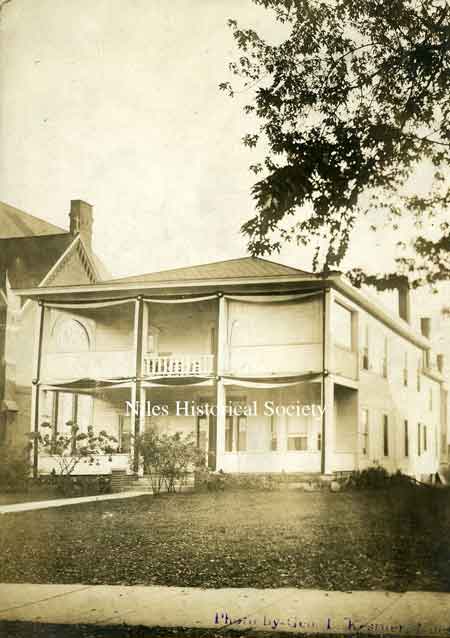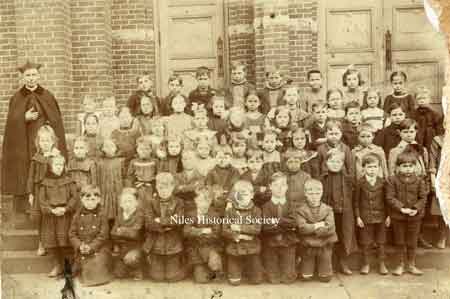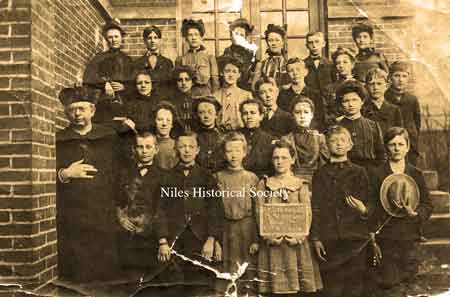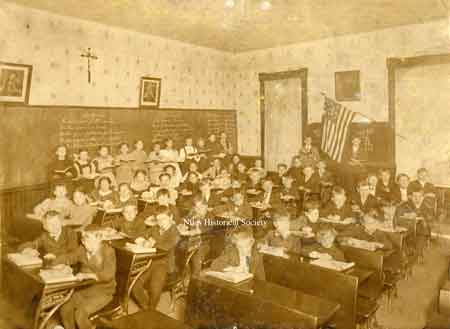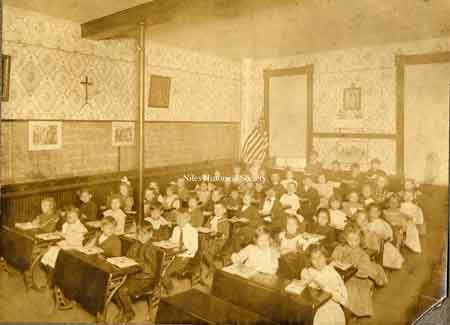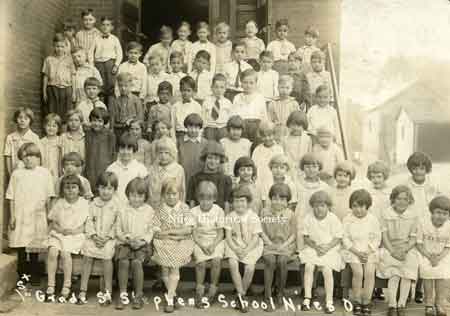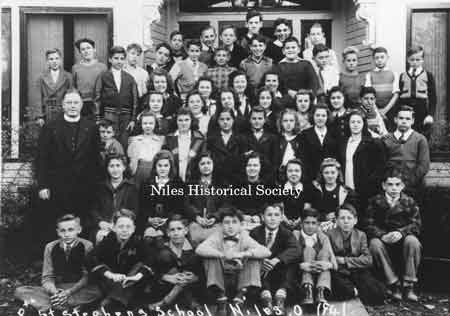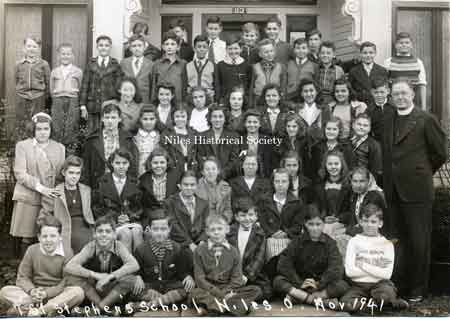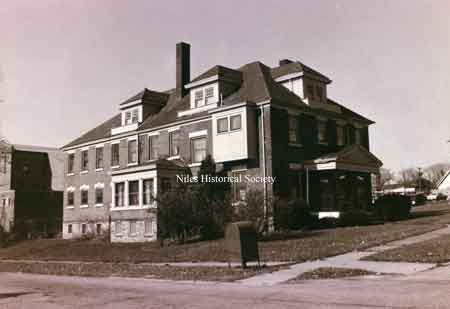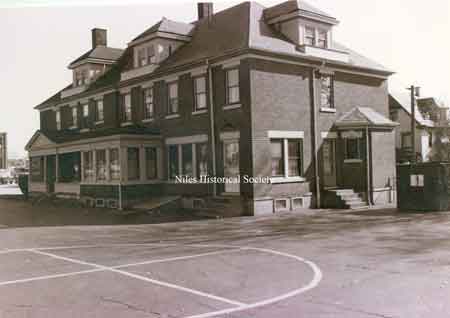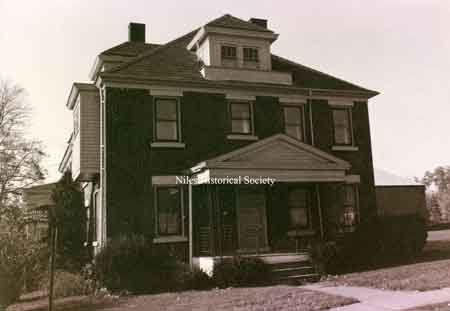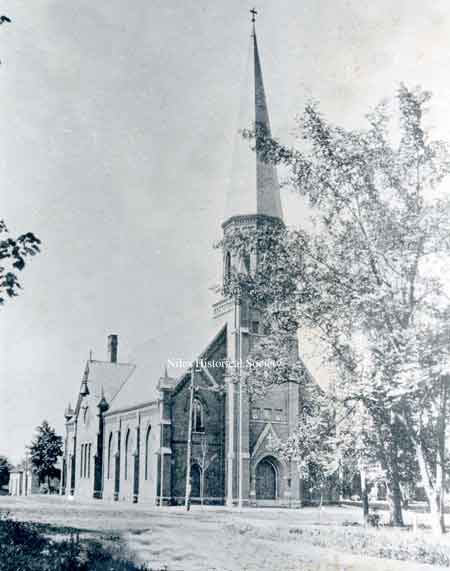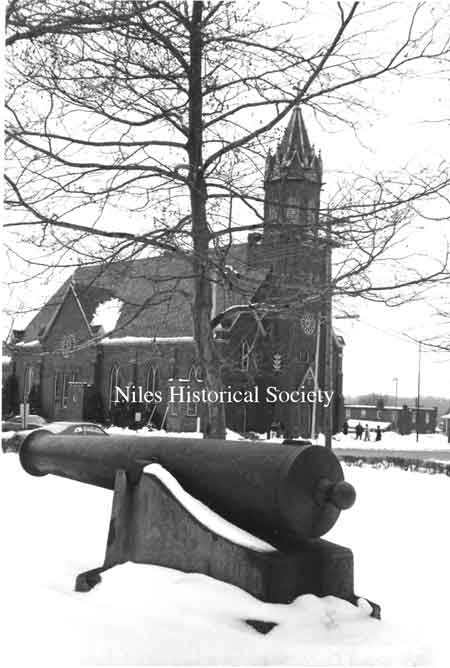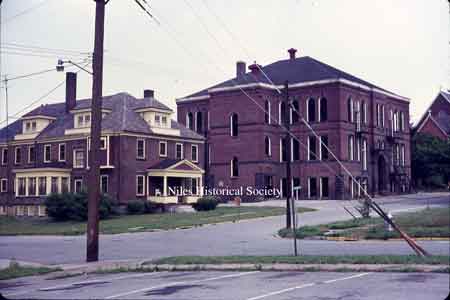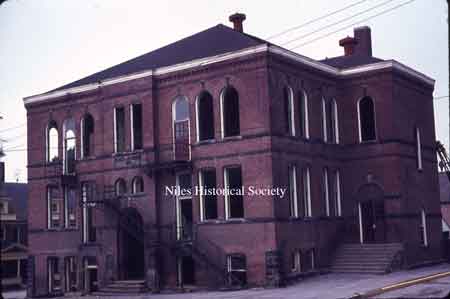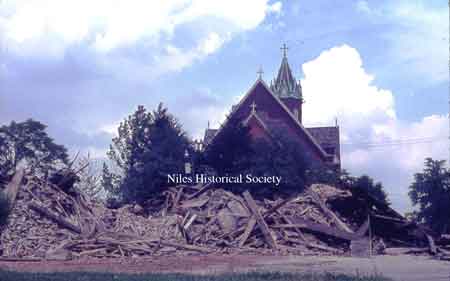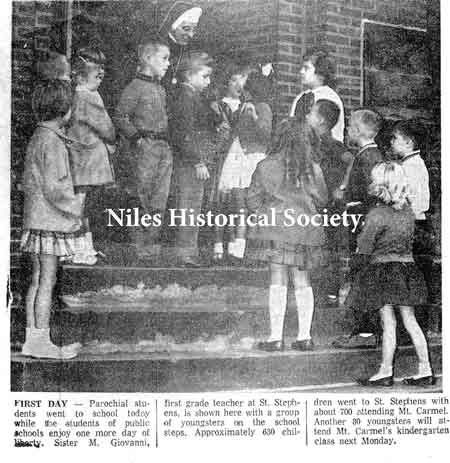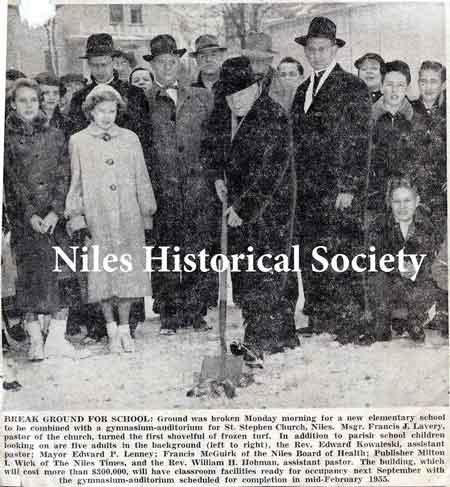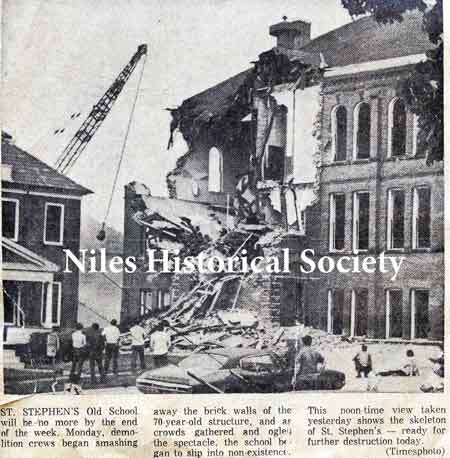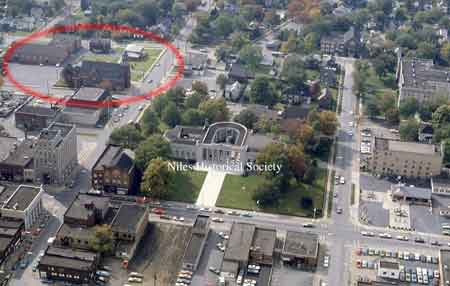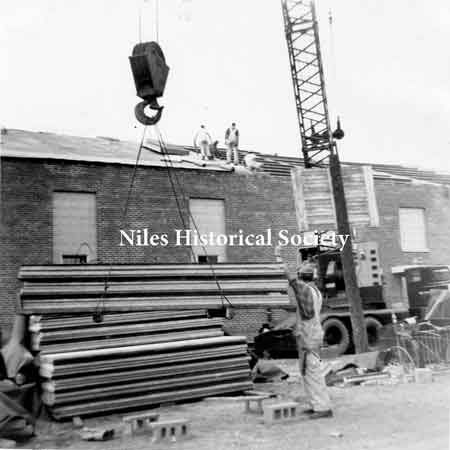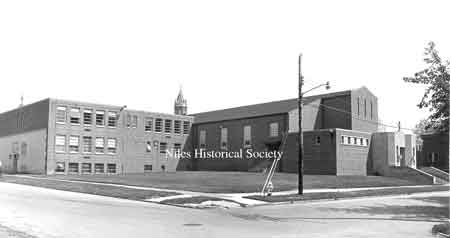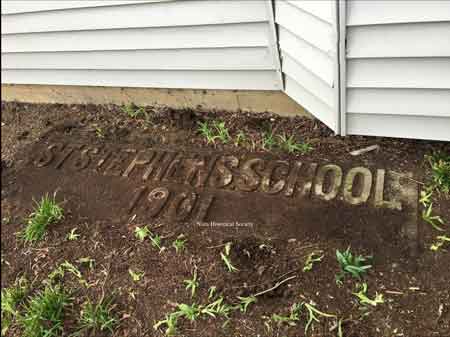Ward-Thomas Museum


St. Stephen Church and School History in Niles Ohio
Ward — Thomas
Museum
Home of the Niles Historical Society
503 Brown Street Niles, Ohio 44446
To
purchase a high-resolution print of any photograph on this page without
the visible watermark,
E-Mail Us Use
the image ID Example: PO1.1023
Click on any photograph to view a larger image.
News
Tours
Individual Membership: $20.00
Family Membership: $30.00
Patron Membership: $50.00
Business Membership: $100.00
Lifetime Membership: $500.00
Corporate Membership:
Call 330.544.2143
Do you love the history of Niles, Ohio and want to preserve that history and memories of events for future generations?
As a 501(c)3 non-profit organization, your donation is tax deductible. When you click on the Donate Button, you will be taken to a secure Website where your donation will entered and a receipt generated.
|
St. Stephen's Catholic Church in August 1975. The building is located on the southwest corner of West Park Avenue and South Arlington Avenue in Niles, Ohio. PO1.342 Front view of St. Stephen's Catholic Church on the corner of West Park and Arlington Streets in downtown Niles, Ohio. PO1.341 |
St. Stephen Church and School History in Niles Ohio. About the middle 1800s the Industrial Revolution
showed its influence in Niles as industries As early as 1853, the spiritual welfare of the
Niles Catholics was entrusted to the resident At the present time (1934) the attendance in the parish school numbers 176. As there is no parochial school connected with the other Niles Catholic parish, which is exclusively Italian, St. Stephens’ school also takes care of some of the children of the sister congregation. |
|
| |
||
|
Looking north along Arlington Avenue from West State Street between 1901 and 1908. St. Stephen's Roman Catholic Church, St. Stephen’s School and St. Stephen Academy of Music as they appeared in 1905. The building on the left was the Academy of Music. Operated separately from the parish school, the Academy had an enrollment of as many as 150 students at one time. This site continued to serve as the residence of the Sisters of the Humility of Mary until 1989. All of these buildings were remodeled in the 1920s. The school bell tower was removed in 1948. St. Stephen’s School was torn down in the summer of 1971. The convent was razed in 1998. PO1.1197.1 |
In
1898, a music academy was added by the sisters of the parochial
school. This music department, as the years rolled by, became
an important branch of the educational system of St. Stephens’.
From a few students in the early years, the number of pupils has
grown to over 150. This large number requires the constant time
of two sisters. Note: The preceding was written in 1934. No sources have been listed, and the author is unknown. |
|
|
||
| Between 1885 and 1888, St. Stephens parish
enjoyed a steady growth. As a result, the church became too
small and provisions were made for a larger place of worship.
Father O’Brien, in the summer of 1888, began
raising funds for the new church which Father Desmond
continued with success. |
||
|
Taken sometime between 1908 and 1915, this image is looking west from the Public or Commons Park, which was located on the northeast corner of Arlington Avenue and West Park Avenue. The park is now a part of the McKinley Memorial grounds. St. Stephen’s Church is on
the left. The old The porch of the old Town Hall is visible on the extreme right. It was demolished in 1915 to make way for construction of the McKinley Memorial Building. |
View of the east side of St. Stephen's Catholic Church taken from behind the post office in the 1970s. The original steeple rose much higher above the church and was struck by lightning many times. It was finally shortened in the mid 1920s. The sanctuary, located on the south side of the building, was destroyed by fire on May 29, 1923. If one compares this photo with the postcard images shown previously, it’s clear that the reconstruction of the new sanctuary resulted in the church being greatly lengthened. S11.92 |
|
|
The original Parish House or Rectory of St. Stephen's Church fronted W. Park Avenue adjacent to the church which is visible on the left-hand side of the picture. It is unclear when this photo was taken. The house is draped in mourning for a deceased priest. This structure no longer exits. The current rectory is located further west on the southeast corner of South Chestnut Avenue and West Park Avenue. PO1.345 |
Unidentified St. Stephen's priest and pupils pose in this photo ca 1900. PO1.1664
St. Stephen's priest, Father Scullin and pupils from Room 4 in 1903. It appears the group may be posing on the steps leading to the northeast entrance of the school. PO1 |
View of a grade school classroom and children attending St. Stephen's parochial school. PO1.1665 View of a grade school classroom and children attending St. Stephen's parochial school. PO1.1666 |
|
|
||
|
First grade at St. Stephen School in Niles, Ohio unknown date. possibly 1933. PO7.38 |
St. Stephen School 8th grade, 1941. PO7.39 |
St. Stephen School 7th grade, 1941. PO7.45 |
| |
||
|
View of the Holy Humility of Mary Convent which was located on the northwest corner of South Arlington Avenue and West State Street. These nuns taught at St. Stephen's parochial school. At one time this building also housed the St. Stephen’s Academy of Music. Though it is unclear exactly when this building was constructed, records indicate that it was operating as St. Stephen’s Academy as far back as 1898. The Academy was enlarged when twelve more rooms and an altar were added to the structure in the 1920s. Again, compare this photo to the previous postcard images. In June 1989, the Sisters of Humility of Mary departed St. Stephen’s Parish after more than 100 years of service. Sisters Mary Slick, Margaret Burgess, and Kathryn Conry were the last remaining nuns at St. Stephen’s and were honored with a farewell Mass and reception. PO1.2065 Their roles as teachers at St. Stephen’s School were filled by the laity. This image was taken before the convent was razed in 1998. The building on the left is the new St. Stephen’s School. PO1.2065 |
View of the Holy Humility of Mary Convent from the rear. The building on the far right still stands on the southwest corner of South Arlington Avenue and West State Street. It
was the former home of William and Catherine Jenkins.
After the death of Mrs. Jenkins in 1961, the property was acquired
by |
View of the front entrance of the Holy Humility of Mary Convent on South Arlington Avenue. PO1.2067 |
|
St. Stephen's Church on the southwest corner of West Park Avenue and South Arlington Avenue is a red brick building of Romanesque style. Work on the foundation began in 1888, and the first Mass was celebrated on Christmas Day in 1891. The new church replaced a frame structure which had served area Catholics since 1864. That wooden church was moved southwest to a lot fronting the north side of Mill Street prior to the construction of the new brick edifice. It would serve as a parochial school until work on a new brick school was begun in 1900. It is believed that the smaller
building pictured on the far left in the image above was one of
two other wooden structures which were also |
The original steeple of St. Stephen's Church was struck by lightning several times, this photo shows the damage when the steeple was struck in 1906. Notice the difference between the height of the original steeple(L) and the current steeple(R). |
Photo taken of St. Stephen's Church from the grounds of the McKinley Memorial in March 1975. In the foreground is the old Civil War cannon. The brick dwelling in the background on the right was located at 23-25 South Chestnut Avenue. It has since been demolished. PO1.343 |
| |
||
|
View of St. Stephen's Music Academy. Built in 1900, it became the convent of the blue nuns of Humility of Mary that taught at St. Stephen's School. This picture was taken before the school building was razed in 1971. SO11.95 |
View of the old St. Stephen's School on South Arlington Avenue. This brick building replaced two wooden framed structures (possibly the original St. Stephen’s Church) which formerly served as classrooms for the parish school. Construction began in 1900 at a cost of about $25,000. The new school was dedicated in 1901. After the opening of the new St. Stephen’s School in 1954, this building continued to be used for various purposes until it was finally condemned in 1968. This picture was taken just before the building was razed in July 1971. SO11.91 |
Demolition of the old St. Stephen's School building in 1971. This area became part of the playground for the new school. SO11.93 |
| |
||
|
Unknown Date |
February 8, 1954 |
July 27, 1971 |
View of the new St. Stephen’s School located on the northeast corner of West State Street and South Chestnut Avenue. The first classes were held in
there on September 8, 1954, with an enrollment of In 1976, around 325 students were enrolled, kindergarten to eighth grade. By the beginning of the 2013/14 calendar year, enrollment had dwindled to just 88 pupils, forcing the parish to close St. Stephen’s School for good at the end of that year. The building was sold in 2019 and is now operated as the Niles Preparatory Academy. PO1.1199. |
||
|
School marker that was over the main entrance of the old St. Stephen's School. |
St. Stephen School Marker
Mystery As I said in our phone conversation, my girlfriend's mother moved into a house on Bowman Street not long ago. Taking advantage of the nice weather, they were raking out and weeding near the back of the house when all of a sudden the rake struck something under the dirt. Clearing away the debris they found this cement marker that measures about seven feet long, twenty two and one half inches wide and three inches thick. The house was previously owned by Robert and Alberta Ellwood. (Mr. Elwood was Irish and would dress up as a leprechaun on St. Patrick's Day). Story and photograph by David Gill. The following was reported by Marci Ellwood:
It came from the old St.Stephen School when it was torn down.
..my mothe- in-law wanted it . Ernie Labruno, the school
janitor told the family there was no way in hell they could possibly
haul it away. Being "Ellwood's " they were challenged.
My husband, his brothers and uncle picked it up and put it in
back of their station wagon then took it to my mother-in-law's
home. |
|
| The Growth of Niles Churches — Grace Allison
|
||
